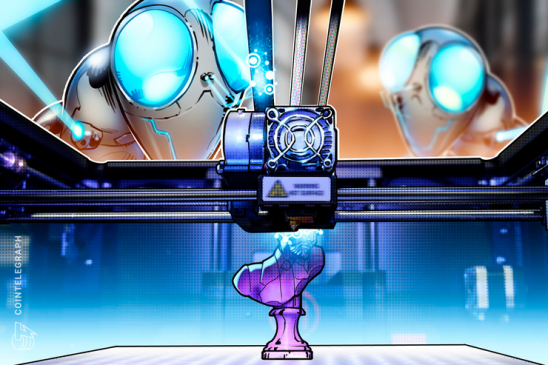Blockchain, like many other emerging technologies, is enthusiastically touted as a solution to many of the world’s problems. Perhaps because of its relation to cryptocurrency or the narrative prophecies that surround them both, blockchain draws both criticism and praise from a staggering array of sectors.
However, with the big blockchain push from Chinese President Xi Jinping along with many tech, finance and industry giants piloting blockchain implementation, the number of use cases grows with each passing day. While cryptocurrency more often draws ire from the mainstream financial world, it seems that for blockchain, the sky’s the limit — but not for long.
A combination of blockchain and 3D printing for aircraft parts may launch the technology into the stratosphere. Cointelegraph spoke to major players in aerospace, including Ernst & Young’s global blockchain leader about blockchain’s vast potential to impact global business through 3D printing.
Moog Inc. trials blockchain
Man first took to the skies in 1903. Orville Wright, poised at the controls of what now seems a laughably simple aircraft, changed the path of humanity’s progression forever. From that bumpy, unceremonious take-off in a North Carolina field grew a titanic industry that would support humanity’s desire to test the limits of creativity.
In 2019, up to 20,000 planes are in the sky at any one time, and the process of building up and maintaining such a gargantuan fleet of aircraft has been a complex and intricate process. Innovations that improve the performance of planes are widely publicized and play an important role in the profitability of aircraft producers. The market is increasingly crowded and companies are racing to develop breakthroughs before their competitors. Despite this, the industry that has grown around the maintenance of the parts that make up an aircraft remains needlessly complex and stuck in the past.
Based in New York state, aircraft parts manufacturer Moog Inc. is trialing a combination of blockchain and 3D printing that could give a creaking industry the rejuvenation it badly needs. As it stands, aircraft parts undergo a long, expensive and time-consuming journey along a complex supply chain. Rightly subject to strict regulation, with all involved companies requiring certification from the Federal Aviation Administration, the process from design to delivery is slow and can take weeks at a time.
Related: Blockchain Adoption Takes Off in Airlines, Aviation Industry
Moog’s solution to streamline production comes in the form of digital blueprints for aircraft components stored in a distributed ledger and printed by a 3D printer. Through the ambitious project, part orders could be completed in a few hours as opposed to a few weeks. If the trial proves successful, product designs will be ready to go on a blockchain and printed on demand, as opposed to mass-produced and shipped from distant locations when needed.
Like many blockchain projects, the goal is to decentralize industries, speed them up, and increase their security. Rather than a linear path from manufacturer to airport, an order from Air New Zealand, for example, took place via a global network of companies. As part of a pilot test, the airline company placed an order for an in-seat screen on one of their Boeing 777-300s while the flight was mid-way between Auckland and its Los Angeles destination.
The airline team in New Zealand ordered the digital blueprint from Singapore Technologies Engineering Ltd. Through Moog’s own Microsoft Azure cloud-hosted blockchain, the order was validated and printed by a 3D printer in Los Angeles. By the time the aircraft touched down in L.A., the part was ready to be installed on-site.
Honeywell also enters the parts trade
Moog is not the only actor in the aerospace sector experimenting with blockchain solutions. Honeywell, another prominent player in aerospace, launched their blockchain platform, GoDirect Trade, last year.
Sathish Muthukrishnan, chief digital and information officer at Honeywell Aerospace, told Cointelegraph that the platform aims to make it easier for airlines, air transport and business aviation customers to access new and used aircraft parts. GoDirect Trade is Honeywell’s in-house solution to the supply chain issues that impede the aerospace industry. Muthukrishnan explained:
“On GoDirect Trade, Honeywell is using blockchain technology to ensure every listing includes images and quality documents for the exact part being offered for sale, giving the buyer confidence about purchasing the part. In addition, every part on GoDirect Trade is immediately available for sale and shipping.”
According to Muthukrishnan, blockchain can not only be used to help supply new parts after a piece has broken or worn out, but also to crack down on poor quality or counterfeit parts entering the market:
“We are working to create a digital engine log book that would revolutionize the way maintenance on an aircraft engine is tracked. We are also nearing the launch of a new partnership that would leverage our blockchain to greatly reduce the possibility of counterfeit aircraft parts hitting the open market. It is worth noting that blockchain can improve traceability throughout the entire value stream of making a certified part, not just the 3D-printing aspect.”
For Muthukrishnan, the cumulative efforts to implement the technology at Honeywell are an attempt to engineer a greater connection between 3D printing and blockchain:
“We see all our efforts in blockchain to date as building blocks to connect blockchain to 3D printing and additive manufacturing. While we can’t go into specifics into how we’re doing this right now, we believe there is strong potential for both Honeywell and the aerospace industry in connecting additive manufacturing and blockchain. The aerospace industry has the potential to benefit from a combination of 3D-printed parts and blockchain technology.”
Ernst & Young Global blockchain lead passionate about 3D printing
For many, the fate of blockchain and crypto are intertwined. With critics fiercely divided over both technologies as a whole, it’s hard to keep track of how far along development and adoption has progressed, if at all. But a milestone development in the last 18 months has been the increased interest and experimentation from institutional entities.
The foray into the sphere by industry giants is not limited to stablecoins and over-the-counter trading. Paul Brody, Ernst & Young’s global blockchain leader, confessed to Cointelegraph that 3D printing is a personal passion of his.
Brody has both worked on a number of key reports and given speeches on the topic. In a conversation with Cointelegraph, he said that he believes there are a number of actionable use cases for the technology regarding 3D printing and intellectual property rights:
“Early on there was some misconception that blockchain could be used to protect IP, and that’s not quite correct. Blockchain is a great tool for distributing, managing, and paying (or being paid) for sharing IP, but it’s not an anti-piracy tool. The way I have to see 3D printing is that it is the manufacturing equivalent of general purpose computing. In the world of General Purpose Computing, any computer can pretty much do most tasks (like the cloud). With 3D printing, we are gradually getting towards something that looks like a manufacturing cloud — and a distributed one.”
For Brody, the massive leaps that humanity made during the industrial revolution are a useful example to learn from when assessing realistic expectations for emerging technology in the modern world. For example, Brody outlined that great industrial breakthroughs like the steam engine needed information technology to scale. The rail and telegraph systems are another perfect combination. He added:
“3D printers will enable distributed manufacturing, and in principle, I believe distributed computing will go hand in hand with that for scaling. From designs to manufacturing to payment, 3D printers are likely to become smart, connected devices in IoT networks. I think you will be able to purchase designs, raw materials, and printing capacity through blockchains and then access networks of distributed manufacturing systems, as one example.”
It’s no secret that blockchain is subject to criticism, as any emerging technology rightly should be. Aside from scalability and the huge amount of energy required to power the technology, perhaps the most important concern is the cost of its implementation.
Brody outlined his view to Cointelegraph that while the cost may seem prohibitive to businesses at present, the fact that most 3D printers are already equipped with the smart technology necessary to connect to blockchains means that over time, the associated financial burden will shrink and decentralized networks will grow:
“In aggregate, blockchain-based systems are likely to be cheaper than centralized systems in the long-run as smart devices do more to manage themselves and depend less on centralized servers. The stage is still a ways off because the overall blockchain infrastructure is still not very mature, but given that most 3D printers are already smart devices, connecting them to blockchains will not be too hard.”
Although EY and a number of other industry leaders are actively exploring blockchain, Brody admits that, as of yet, there is no overwhelming demand to combine blockchain and 3D printing. Nonetheless, Brody thinks that “we’re getting very close on the public blockchain side to the point where adding blockchain interactions to 3D printing systems is easy enough that it can start to scale.”
For Brody, 3D printing is something that has the power to empower business and diversify industry. Having worked on a number of detailed reports for both IBM and EY on 3D printing, Brody emphasized that a new swathe of businesses are only a short while away from being able to implement the technology — a move which could drastically change the economic environment:
“I believe that 3D printing, as it matures, will have a tremendous impact on industries.”




